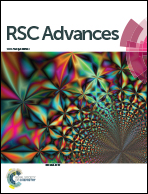Template-free synthesis of mesoporous CeO2 powders by integrating bottom-up and top-down routes for acid orange 7 adsorption†
Abstract
A combined bottom-up and top-down route was developed for the template-free synthesis of mesoporous CeO2 powders using Ce(NO3)3·6H2O, NH4HCO3, H2O2, and H2O as starting reagents. The flake-like Ce2(CO3)3·8H2O precursor was etched by H2O2, and CeO2 nucleated in situ with built-in equiaxed particles. Pores formed on the flakes owing to the loss of by-products of H2O and CO2. The formation of the mesostructured CeO2 could also be explained by the large change in volume induced as a result of the difference in density between Ce2(CO3)3·8H2O and CeO2. Accordingly, the original flake-like morphology of Ce2(CO3)3·8H2O was not preserved upon pore formation and during continuous stirring in the synthesis. A subsequent hydrothermal treatment destroyed the loose aggregates of CeO2 derived from the reaction between H2O2 and Ce2(CO3)3·8H2O. Rearrangement of the CeO2 particles via a dissolution–recrystallization process occurred under certain temperatures and pressures. Consequently, CeO2 particles with coarser sizes, smoother surfaces, and mesoporous structures were obtained. The specific surface area of the particles was 166.5 m2 g−1 after hydrothermal treatment at 200 °C for 24 h. The mesoporous CeO2 particles possessed better adsorption capacities of acid orange 7 dye than basic orange 2 dye in the absence of pH pre-adjustments. The saturated adsorption amount of acid orange 7 dye was 510.2 mg g−1 at 298 K based on Langmuir linear fitting of the experimental data.


 Please wait while we load your content...
Please wait while we load your content...